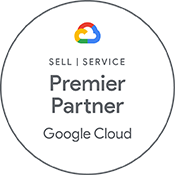 1 day course
1 day course  Partner of the Year
Partner of the Year  Virtual, Private
Virtual, Private  Certificate of Attendance
Certificate of Attendance Jellyfish has been selected by Google to facilitate the delivery of this one-day fundamentals course.
We're an award-winning Google Cloud Partner and our trainers work with Google Cloud on a daily basis, so you'll be able to benefit from the years of industry experience they’ll share with you.
Through a combination of presentations, demos, and hands-on labs, we’ll discuss the value of Google Cloud and how to incorporate cloud-based solutions into business strategies. You'll gain basic knowledge of Google Cloud resource management including Compute Instances, Cloud Networking, GKE, Containers and more.
Our Google Cloud Fundamentals: Core Infrastructure course is delivered via Virtual Classroom. We also offer it as a private training session that can be delivered virtually or at a location of your choice in South Africa.
Course overview
Who should attend:
This beginner-level course is suitable for:
- Individuals planning to deploy applications and create application environments on Google Cloud
- Developers, systems operations professionals, and solution architects getting started with Google Cloud
- Executives and business decision-makers evaluating the potential of Google Cloud to address their business needs
What you'll learn:
By the end of this course, you will be able to:
- Identify the purpose and value of Google Cloud products and services
- Define how infrastructure is organized and controlled in the Cloud
- Explain how to create basic infrastructure in Google Cloud
- Select and use Google Cloud storage options
- Describe the purpose and value of Google Kubernetes Engine
- Identify the use cases for serverless Google Cloud services
Prerequisites
To get the most out of this course, you should have familiarity with the Linux command line, web servers, and text editors.
Course agenda
- Identify the benefits of Google Cloud
- Define the components of the Google Cloud network infrastructure, including points of presence, data centers, regions and zones
- Understanding the difference between infrastructure as a service (Iaas) and platform as a service (Paas)
- Identify the purpose of projects on Google Cloud
- Define the purpose of and use cases for IAM
- List the methods of interaction with Google Cloud
- Use Cloud Marketplace to interact with Google Cloud
- Explore the basics of networking in Google Cloud
- Identify the purpose of and use cases for Google Compute Engine
- Outline how Google Compute Engine can scale
- Detail important VPC compatibilities including routing tables, firewalls and VPC peering
- Explore how Cloud Load Balancing functions in Google Cloud
- Deploy a basic infrastructure to Google Cloud
- Identify the purpose of and use cases for Cloud Storage
- Distinguish between Cloud Storage classes
- Distinguish between Google Cloud's Database storage options
- Deploy an application that uses Cloud SQL and Cloud storage
- Define the concept of a container and identify uses for containers
- Identify the purpose of and use cases of Kubernetes and Google Kubernetes Engine
- Identify the purpose and use cases of Cloud Run
- Describe how Cloud functions can support application development on Google Cloud
- Deploy a containerized Application on Cloud Run
- Recap the content covered in each section of the course


